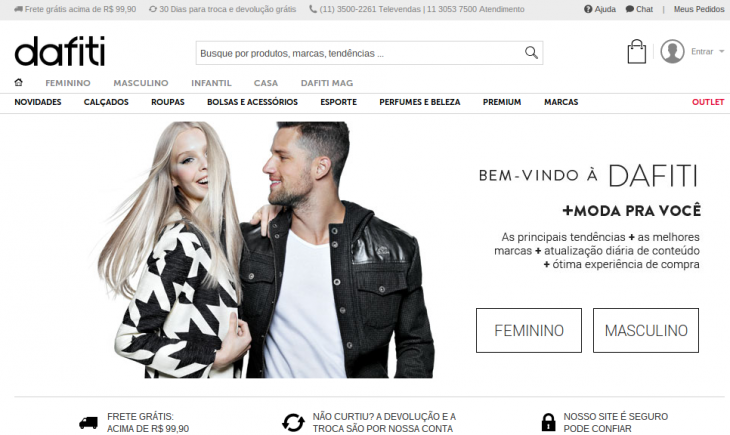
Fashion e-commerce portal Dafiti is undoubtedly one of Latin America’s most interesting companies to watch. Take a close look at it, and you’ll see so many of the trends that have shaped e-commerce in the region. On one hand, you have MBA-equipped, foreign-born founders keen to bring known models to Latin American buyers, with a tremendous amount of funding to support their plans. On the other, a diverse group of countries whose reality made more than one Internet company stumble.
 How does Dafiti plan to make the most of this context? We asked this question and many others to Malte Huffmann, managing director and co-founder of the Dafiti Group, where he is in charge of marketing. A German national, Huffmann previously co-founded German e-commerce player MyBrands and later sold to Zalando, a former Rocket Internet company.
How does Dafiti plan to make the most of this context? We asked this question and many others to Malte Huffmann, managing director and co-founder of the Dafiti Group, where he is in charge of marketing. A German national, Huffmann previously co-founded German e-commerce player MyBrands and later sold to Zalando, a former Rocket Internet company.
Without further ado, here our interview, which has been slightly edited for length and clarity.
Identity
TNW: The media sometimes refer to Dafiti as “the Latin American Zappos,” and to your early investor Rocket Internet as a “clone factory”. Do you agree with these descriptions?
Malte Huffmann: Rocket Internet is a very successful Internet platform which builds companies with proven business models. If you ask me, this is more than fine, as I believe business models shouldn’t be exclusive. I like the market economy and believe in competition. Both require more than just one player. Furthermore, if you look at Dafiti, you can see a unique company which is reshaping the e-commerce markets in Latin America with a clear passion and love for fashion.
Market, funding and challenges
TNW: According to e-Bit, Brazil’s e-commerce grossed 26% more in 2014’s first half than in 2013’s. Do you expect e-commerce and more specifically online fashion retail to keep on growing at this pace?
Malte Huffmann: I definitely do. All of the underlying fundamentals are pointing this way. Internet penetration in Latin American countries is rising, as the access to broadband internet is growing about 16 percent to 18 percent per year.
In Brazil, in the first half of 2014, 5,06 million new customers have just made their first online purchase, which represents a 27 percent growth compared to the previous year. Fashion and accessories were also the highest ranked category in sales in the country. Before Dafiti entered the market, it was the 26th ranked category,
E-commerce is furthermore fueled by mobile growth. In 2013 in Brazil, the sales of smartphones and tablets grew by 122 percent and 144 percent each. M-commerce tripled to 7 percent of e-commerce, reinforcing the trend of shopping via mobile devices.
All of these positive numbers sustain our optimistic projections to 2014 and 2015, and obviously, we are keen to capitalize on these trends and capture the huge market potential.
TNW: Dafiti has raised almost $250 million to date. Is break-even on the horizon? On a related note, and with Baby’s recent acquisition in mind, how can Latin America’s e-commerce heavyweights survive despite their huge initial funding needs?
Malte Huffmann: Our funding history is something we are clearly very proud of, as it reflects our ambitious nature, the results which we have already materialized and the bright outlook for Dafiti. The need for funding in general is something that is not exclusive to Latin American companies, but applies to start-ups throughout the world.
In order to receive funding, you have to have a clear and cohesive set of ideas and trajectories for your company. You need to show investors that your company is in it for the long term, and that the company really has a vision that makes it sustainable for the future. Some companies, such as Dafiti, have been able to do this. We have invested in infrastructure – our backbone – in order to maintain our significant growth. We are benefiting from these investments now.

TNW: What challenges did you face during Dafiti’s first years? Did any of these catch you off-guard or turn out to be bigger than expected? For instance, delivery and logistics have been a headache for e-commerce companies operating in Latin America. How did you work around this?
Malte Huffmann: Delivery and logistics are certainly the major challenges for e-commerce companies, especially in Latin American countries where we have great land extensions and poor infrastructure. We work around this by making the operations processes in-house in order to control for and ensure the high quality standards that we require. We also have a good variety of transportation companies that are constantly measured according to our KPIs.
Investments in technology are also a focus; we invest in new systems, automation and infrastructure as we believe that is the way to do it in the long term, in order to optimize our resources.
User experience
TNW: You operate in markets where many customers are making their first online purchases. How do you take this into account in your marketing strategy and user experience?
Malte Huffmann: We want to give our customers access to the best of fashion, which means that we want to offer a very broad variety of products from top brands to exceptional product curation. To accomplish this, we invest in design and fashion content, so that new customers can feel the difference when shopping for fashion versus for commodities. In addition, in order to make their experience as seamless and easy as possible, we are constantly improving our website according to usability standards and tests.

TNW: You offer free exchanges and returns. Why, and do you think it will become the standard in Latin America?
Malte Huffmann: Dafiti wants to create the best user experience for its customers as well as make online shopping easy. Our customers should get the exact product that they want, and we believe that offering free exchanges and returns should be mandatory. A satisfied client will not only return to Dafiti but also recommend us to their friends.
Perhaps other companies will slowly start to see that this is truly the way to go, and maybe this will one day become standard as well across Latin America.
TNW: Dafiti hoped to stand out with its user experience, in a region where e-commerce generates many customer complaints. However, your company recently received a hefty fine from São Paulo’s Foundation of Protection and Consumer’s Defence for Deficient Customer Care. What happened and how do you plan to improve?
Malte Huffmann: As part of our efforts and investment in technology we changed our operational system, so it clearly impacted our operations and customer services. Although 90 percent of all orders are already being processed and delivered on time, in a large company like Dafiti, if we have 1 percent of unsatisfied clients, that means that thousands of people have been affected. We know that it’s not acceptable for our standards, so we have dedicated teams and made new hires in order to make sure that these issues will be 100 percent solved.
Before this, we were one of the best customer services do Brazil with 90 percent of the Net Promoter Score (NPS), our main index to measure client satisfaction – the average NPS of the Brazilian e-commmerce is about 59 percent. We also have labels from the major customer organizations like e-Bit and Reclame Aqui, so I believe that it’s a temporary situation and we will soon reestablish our standards of excellence.
Working conditions
TNW: Companies often say it is hard to hire qualified employees in Brazil. Can you share some numbers about Dafiti’s workforce? How did you manage to scale it so quickly?
 Malte Huffmann: Operations exist in Brazil, Argentina, Chile, Colombia and Mexico, with more than 2,500 workers employed in the region. This is quite significant, because when you think about it, we were created in January 2011. The vast majority of our workforce consists of local people, which is quite significant for a company of our size and scope.
Malte Huffmann: Operations exist in Brazil, Argentina, Chile, Colombia and Mexico, with more than 2,500 workers employed in the region. This is quite significant, because when you think about it, we were created in January 2011. The vast majority of our workforce consists of local people, which is quite significant for a company of our size and scope.
In terms of managing to scale it so quickly, we really didn’t find it that hard. I think that working at Dafiti is a very attractive opportunity to many, and we attract very high-caliber people as seen through our competitive salaries as well as attractive working conditions. We also have a good team-playing environment and programs aimed at sharing knowledge, such as Dafiti multipliers, where employees give classes to their colleagues on topics ranging from fashion to finance.
TNW: Some of your foreign counterparts have been criticized for their poor working conditions. What are Dafiti’s standards?
At Dafiti, our standards are pretty simple. We believe in creating an environment where not only our customers can profit, but also where our employees are proud of being. We emphasize the belief of keeping our production as regional as possible and giving employees the chance to learn and grow inside of our company.
 Our distribution center and head office were built keeping in mind the welfare of our people; for example, in the head office the decoration and ambiences are made to follow a fashion concept, which completely align with our core business.
Our distribution center and head office were built keeping in mind the welfare of our people; for example, in the head office the decoration and ambiences are made to follow a fashion concept, which completely align with our core business.
TNW: On the other hand, as a third-party retailer, how does Dafiti promote corporate social responsibility in the fashion industry?
Malte Huffmann: Dafiti emphasizes sustainable and locally-sourced goods, which allows it to also employ a sizeable number of local workers in the process, keeping production as regional as possible. As stated before, operations exist in Brazil, Argentina, Chile, Colombia and Mexico, with more than 2,500 employees in the region, all local. We believe that by doing so, we are promoting corporate social responsibility. We want to invest in this region and its people and therefore, we believe that our emphasis on this is key to Dafiti’s success.
TNW: In concrete terms, what measures does Dafiti takes when a brand is accused of using slave labor, which was the case of M. Officer and some others over the last few months?
Malte Huffmann: We are investigating and following up this situation. If all accusations are proven to be true, we will certainly take the necessary actions. In addition, we are improving our suppliers’ negotiations and contracts in order to avoid brands with behavior and business models that we do not agree with.
Future plans
TNW: Dafiti now operates in Argentina, Brazil, Chile, Colombia and Mexico; do you plan to further expand in Latin America?
Malte Huffmann: Today, Dafiti is the only fashion e-commerce to operate in the five biggest Latin American markets. We are leader in all countries and our focus is to consolidate our presence and expand our portfolio in each one of them.
TNW: How do you feel about new entrants in your market segment, for instance Lük or MercadoLibre with its fashion vertical?
Malte Huffmann: We think that with the significant growth that Dafiti has made in the last years, it certainly arose the interest of other players to enter in the fashion online market. We are continuing to invest in order to make a difference to our customers, bringing new fashion content, product curation and tailor-made content.
Selling fashion is different from selling commodities such as electronic devices. It’s about the presentation, the content and the experience of seeing the product. You need to create a desire and impulse to buy it. We are constantly innovating and providing unmatched experience for the customer.
Selling better is one part but we are also excelling at providing the best and fastest after-sales services, such as same-day delivery, weekend delivery and automated return. This differentiates us even more from other players on the market which do not have the same standards or quality of services.
TNW: How and why did you launch Dafiti Sports?
 Malte Huffmann: We launched Dafiti Sports in order to fulfill a new consumer segment in Brazil. Sports clothes, shoes and equipment were categories with high demand and we saw an opportunity to target a specific sports market. As a result, we launched Dafiti Sports in August 2012 and since then we have been growing 100% per quarter, proving that this market actually needs another strong player to begin with.
Malte Huffmann: We launched Dafiti Sports in order to fulfill a new consumer segment in Brazil. Sports clothes, shoes and equipment were categories with high demand and we saw an opportunity to target a specific sports market. As a result, we launched Dafiti Sports in August 2012 and since then we have been growing 100% per quarter, proving that this market actually needs another strong player to begin with.
TNW: What role does (and will) mobile play for Dafiti?
Malte Huffmann: In order to tap into Brazil’s growing sector of smartphone users (142% growth in 2013), Dafiti has created and improved our mobile apps to include Android and iOS platforms and invested in responsive design.
 We definitely believe that m-commerce will be even more visible in the future, and even today we can feel the potential, as our mobile traffic amounts to about 16% of the total visits, a figure that has almost tripled since last year. To guarantee innovation and usability we have dedicated IT and Marketing teams working on mobile platforms and solutions.
We definitely believe that m-commerce will be even more visible in the future, and even today we can feel the potential, as our mobile traffic amounts to about 16% of the total visits, a figure that has almost tripled since last year. To guarantee innovation and usability we have dedicated IT and Marketing teams working on mobile platforms and solutions.
Let’s conclude with a word on the elephant in the room, Amazon. While it has finally set foot in Brazil in December 2012, its product range in the country is currently limited to e-books and e-readers.
It wouldn’t be surprising to see Amazon venture into other verticals in the next few years, but one thing is for sure: the more it waits, the more space it leaves to players such as Dafiti, Bebê Store and Netshoes.
Get the TNW newsletter
Get the most important tech news in your inbox each week.





